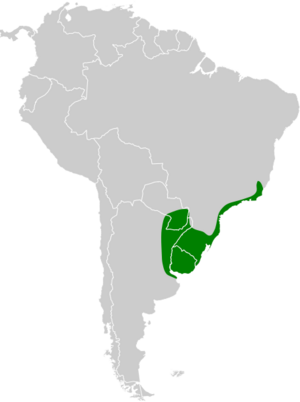Red-and-white crake facts for kids
Quick facts for kids Red-and-white crake |
|
|---|---|
 |
|
| At Intervales State Park, São Paulo state, Brazil | |
| Conservation status | |
| Scientific classification | |
| Genus: |
Laterallus
|
| Species: |
leucopyrrhus
|
 |
|
The red-and-white crake (Laterallus leucopyrrhus) is a species of bird in subfamily Rallinae of family Rallidae, the rails, gallinules, and coots. It is found in Argentina, Brazil, Paraguay, and Uruguay.
Contents
Taxonomy and systematics
The red-and-white crake is monotypic.
Description
The red-and-white crake is 14 to 17 cm (5.5 to 6.7 in) long and weighs 34 to 52 g (1.2 to 1.8 oz) with an average of about 45 g (1.6 oz)). The sexes are alike. Their head, neck and back are bright chestnut with a sharp demarcation from their white throat and breast. The rest of their upperparts are dark olive brown, and their flanks are barred black and white. Their unique undertail coverts as a whole have a black center and white edges. Their legs are bright coral red to salmon-pink and their bill is black with a yellow base and mandible and a light green to light blue tip.
Distribution and habitat
The red-and-white crake is found in southeastern Brazil from Río de Janeiro state south through eastern Paraguay and much of Uruguay into northeastern Argentina as far as northern Buenos Aires Province. It inhabits a variety of wet landscapes that generally have shallow water to moist soil, tall or matted grasses or reeds, and often shrubs, thickets, and scattered small trees.
Behavior
Movement
The red-and-white crake appears to be a year-round resident throughout its range.
Feeding
The red-and-white crake usually forages by itself, walking on the ground or climbing among vegetation. Its diet is mostly small invertebrates such as insects and worms, and also includes seeds.
Breeding
The red-and-white crake's breeding season in Argentina appears to span from October to February but is not known elsewhere. Both sexes build the nest, which is a ball of grass, herbs, and reeds attached to marsh vegetation up to about 1 m (3 ft) above the ground. It has a side entrance. The typical clutch size is three eggs. In captivity the incubation period is about 24 days and young are independent in about four weeks.
Vocalization
The red-and-white crake's song is "a prolonged throaty chatter; also described as a resonant trill", sometimes given in duet. An alarm call is "a low cui whistle" and a call believed to be aggressive is a "harsh chrrrrrr...".
Status
The IUCN has assessed the red-and-white crake as being of Least Concern. It has a fairly large range, but its population size and trend are not known. No immediate threats have been identified. However, "habitat destruction by urban growth, land filling and livestock grazing" have a direct effect.


